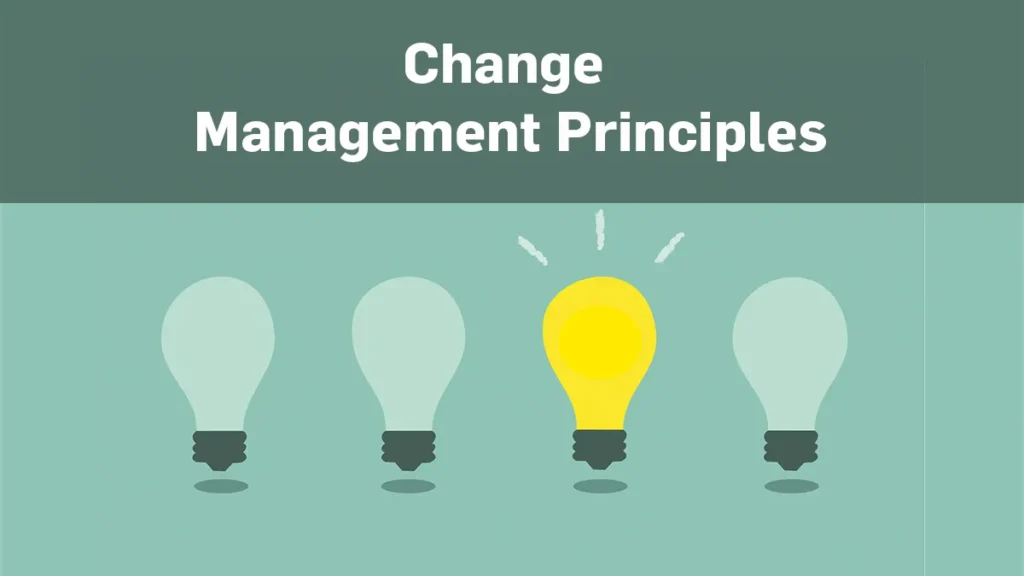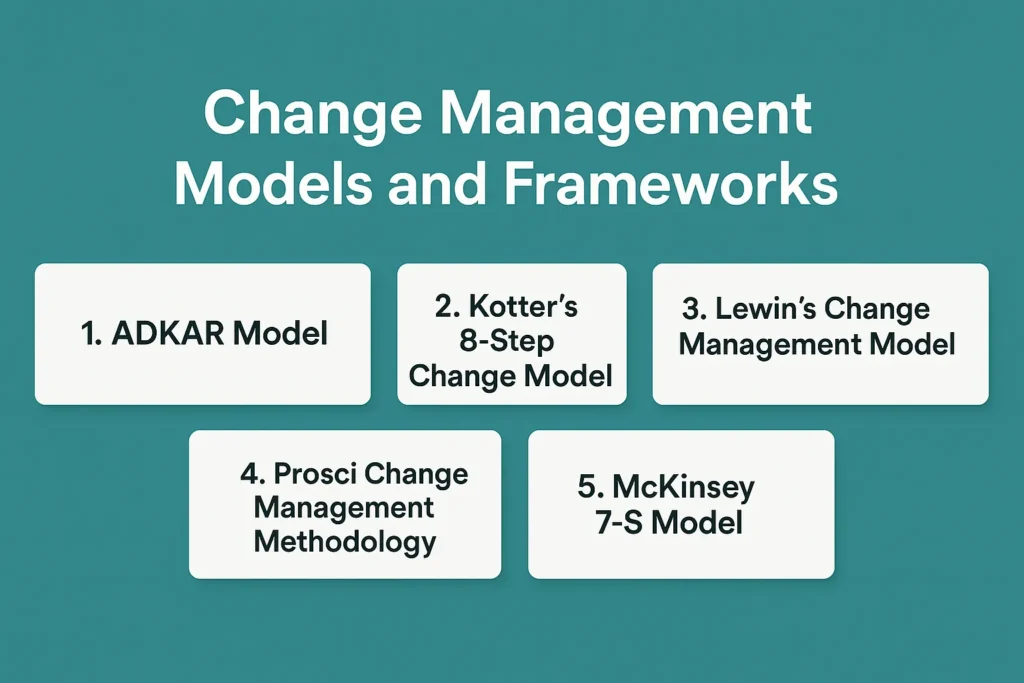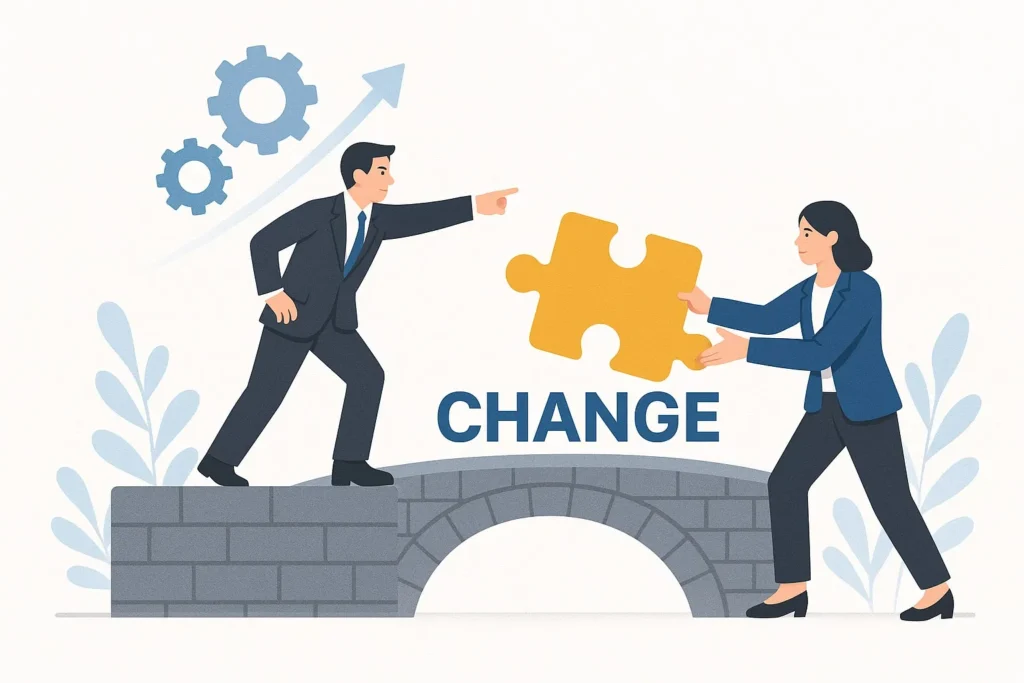
Executive Summary
In today’s dynamic business environment, organizations must adapt to survive and thrive. Change management is the structured approach to preparing, supporting, and helping individuals, teams, and organizations transition from a current state to a desired future state. It ensures that changes—whether in processes, technology, organizational structures, or culture—are implemented smoothly, efficiently, and with minimal disruption.
This comprehensive guide explores what change management is, its principles, processes, benefits, challenges, and real-world applications, providing a roadmap for organizations to navigate transformation successfully.
Table Of Content
- Executive Summary
- 1. Strategic Change
- 2. Structural Change
- 3. Process Change
- 4. Technological Change
- 5. Cultural Change
- 1. Preparing for Change
- 2. Planning Change
- 3. Implementing Change
- 4. Managing Resistance
- 5. Sustaining Change
- 1. ADKAR Model
- 2. Kotter’s 8-Step Change Model
- 3. Lewin’s Change Management Model
- 4. Prosci Change Management Methodology
- 5. McKinsey 7-S Model
Understanding Change Management
Change management is not just about implementing new processes or technologies—it’s about managing the human side of change. People often resist change, whether due to fear, uncertainty, or habit. Change management focuses on addressing these human factors, ensuring that employees are engaged, informed, and empowered to embrace the transition.
Change management ensures that organizational transformations deliver tangible benefits, sustain improvements, and align with strategic objectives.
Why Change Management Matters
- Reduces Resistance: Engages employees to accept and support change.
- Ensures Smooth Transition: Minimizes disruption to operations and productivity.
- Increases Adoption: Promotes faster and more effective use of new systems or processes.
- Supports Strategic Goals: Aligns change initiatives with business objectives.
- Enhances Communication: Keeps stakeholders informed and aligned.
- Maximizes ROI: Ensures investments in change initiatives deliver measurable value.
Without effective change management, even the best strategies, technologies, or processes can fail to achieve desired outcomes.
Key Principles of Change Management
Effective change management relies on several guiding principles:

- Leadership Alignment: Leaders must model and support the change.
- Clear Vision: A well-defined goal helps employees understand why the change is necessary.
- Stakeholder Engagement: Involving key stakeholders early fosters ownership.
- Effective Communication: Transparent, consistent messaging reduces uncertainty.
- Employee Support: Training, coaching, and resources help individuals adapt.
- Measurement and Feedback: Tracking progress and adjusting strategies ensures success.
These principles ensure that change is structured, consistent, and sustainable.
Types of Organizational Change
Organizations may undergo various types of change, each requiring tailored strategies:
1. Strategic Change
Long-term shifts that affect the organization’s overall direction, such as entering new markets or adopting a new business model.
2. Structural Change
Adjustments to the organization’s hierarchy, roles, or reporting relationships.
3. Process Change
Modifications to workflows, procedures, or operational systems to improve efficiency or quality.
4. Technological Change
Implementation of new tools, software, or systems to support business operations.
5. Cultural Change
Shifts in organizational values, norms, or behaviors to foster a desired workplace culture.
The Change Management Process
Change management is typically implemented through a structured process to guide organizations and employees through transitions.
1. Preparing for Change
- Assess the organization’s readiness
- Define the change vision and objectives
- Identify key stakeholders and change agents
- Conduct impact analysis
2. Planning Change
- Develop a comprehensive change management strategy
- Create a communication plan
- Identify training and support needs
- Set measurable goals and success criteria
3. Implementing Change
- Execute communication campaigns to inform stakeholders
- Provide training, coaching, and support to employees
- Roll out new processes, technologies, or structures
- Monitor adoption and address resistance proactively
Successful change implementation depends on how effectively teams plan, allocate resources, and align with organizational goals.
- For a complete foundation on structured execution, explore What Is Project Management? to understand the processes that make change achievable.
- When change impacts multiple projects or departments, The Ultimate Guide to Program Management explains how to maintain alignment across organizational programs.
- People are at the heart of change — What Is Workforce Management? outlines strategies for scheduling, engagement, and communication during transitions.
- Finally, to ensure smooth operational adjustments, What Is Resource Coordination in Incident Management highlights how to balance assets and personnel throughout change initiatives.
4. Managing Resistance
- Identify sources of resistance
- Engage employees through dialogue and feedback
- Reinforce benefits of the change
- Offer support and resources to overcome obstacles
5. Sustaining Change
- Monitor long-term adoption and performance
- Adjust strategies as necessary
- Celebrate successes and recognize contributions
- Integrate changes into organizational culture and processes
Change Management Models and Frameworks
Several frameworks guide organizations in implementing change effectively:

1. ADKAR Model
Focuses on individual change through Awareness, Desire, Knowledge, Ability, and Reinforcement.
2. Kotter’s 8-Step Change Model
Emphasizes leadership and organizational alignment through steps like creating urgency, building a guiding coalition, and anchoring changes in culture.
3. Lewin’s Change Management Model
A three-stage approach: Unfreeze → Change → Refreeze, focusing on preparing for change, implementing it, and making it stick.
4. Prosci Change Management Methodology
A structured, research-based approach emphasizing people, processes, and results.
5. McKinsey 7-S Model
Addresses Strategy, Structure, Systems, Shared Values, Skills, Style, and Staff to ensure holistic organizational alignment during change.
Tools and Techniques in Change Management
Modern change management leverages tools to facilitate communication, engagement, and monitoring:
- Stakeholder Analysis Matrices: Identify influence, impact, and support levels
- Change Impact Assessments: Evaluate how change affects individuals and teams
- Communication Platforms: Internal newsletters, intranet portals, and digital campaigns
- Training and E-Learning Tools: Equip employees with necessary skills
- Feedback Mechanisms: Surveys, focus groups, and performance tracking dashboards
- Project Management Software: Track progress, milestones, and adoption metrics
These tools enhance clarity, engagement, and accountability.
The Role of a Change Manager
A Change Manager ensures that organizational changes are implemented smoothly. Key responsibilities include:
- Developing change management strategies and plans
- Engaging stakeholders and managing resistance
- Coordinating training and support initiatives
- Monitoring adoption and measuring success
- Reporting progress to leadership and adjusting strategies
Successful change managers combine leadership, communication, and analytical skills to guide organizations through transitions.
Benefits of Effective Change Management

- Higher Adoption Rates: Employees embrace changes faster.
- Reduced Resistance: Clear communication and engagement reduce pushback.
- Improved Productivity: Smooth transitions minimize disruptions.
- Strategic Alignment: Change initiatives support business objectives.
- Enhanced Morale: Employees feel supported and valued.
- Sustained Improvements: Changes are embedded in processes and culture.
Organizations that excel in change management are more agile, competitive, and resilient in a constantly evolving business landscape.
Challenges in Change Management
Despite its importance, change management faces common challenges:
- Employee resistance and fear of the unknown
- Lack of leadership commitment or alignment
- Poor communication strategies
- Insufficient resources or training
- Difficulty measuring adoption and impact
Overcoming these challenges requires proactive planning, leadership engagement, and continuous feedback loops.
Real-World Examples of Change Management
- Digital Transformation: Organizations adopting cloud-based platforms often require extensive training, communication, and process redesign.
- Mergers and Acquisitions: Integrating two company cultures, systems, and structures demands careful planning and change leadership.
- Process Improvement Initiatives: Implementing Lean or Six Sigma methodologies involves modifying workflows and employee behavior.
- Organizational Restructuring: Realigning teams and reporting structures requires engagement and support to maintain productivity.
These examples highlight how structured change management ensures smooth transitions and successful outcomes.
Future of Change Management
The landscape of change management is evolving:
- Digital Tools: AI, analytics, and collaboration platforms support adoption and measurement.
- Agile Change Management: Flexible approaches allow faster response to evolving business needs.
- Employee-Centric Strategies: Emphasizing engagement, culture, and behavioral change.
- Data-Driven Decision Making: Metrics and dashboards inform strategy and effectiveness.
- Sustainability and ESG Integration: Change management increasingly includes social, environmental, and governance considerations.
The future focuses on adaptive, technology-enabled, and human-centered change.
Conclusion
Change management is essential for organizations navigating today’s fast-paced, complex environment. By planning, engaging, supporting, and monitoring change, organizations can minimize disruptions, enhance employee adoption, and achieve desired outcomes.
Whether implementing technology, redesigning processes, or transforming culture, effective change management ensures that change is not just implemented but embraced, driving long-term success and strategic growth.


